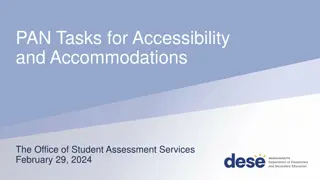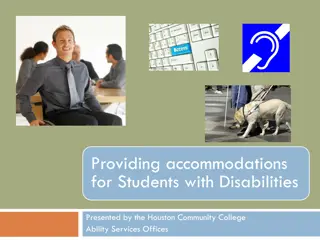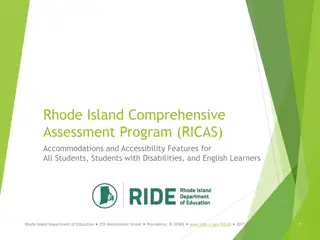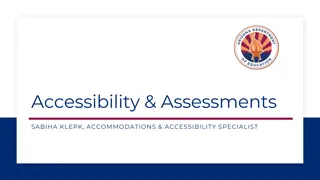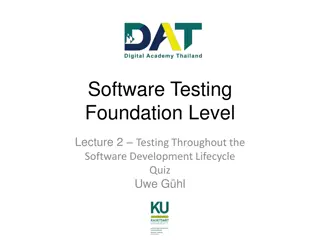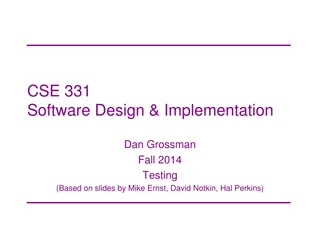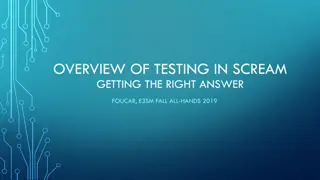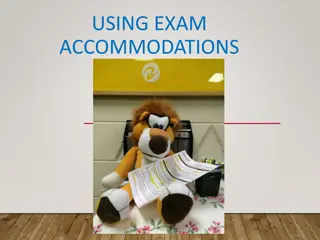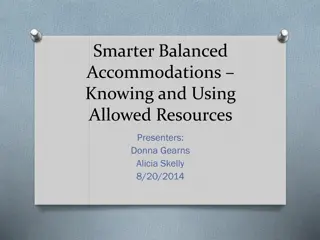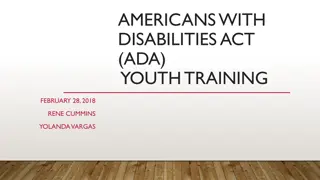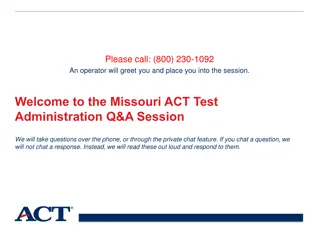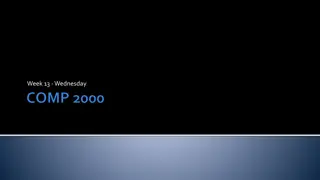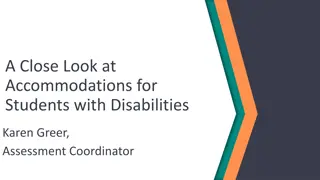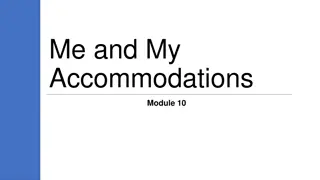Accommodations and SOL Testing Overview
An overview of accommodations and SOL testing by Carol Jennings, Assessment Coordinator, emphasizing the importance of following official guidelines and manuals when administering tests with accommodations. The presentation covers online testing requirements, allowable provisions for all students, small group sizes, and environmental modifications for optimal testing conditions.
Download Presentation

Please find below an Image/Link to download the presentation.
The content on the website is provided AS IS for your information and personal use only. It may not be sold, licensed, or shared on other websites without obtaining consent from the author.If you encounter any issues during the download, it is possible that the publisher has removed the file from their server.
You are allowed to download the files provided on this website for personal or commercial use, subject to the condition that they are used lawfully. All files are the property of their respective owners.
The content on the website is provided AS IS for your information and personal use only. It may not be sold, licensed, or shared on other websites without obtaining consent from the author.
E N D
Presentation Transcript
ACCOMMODATIONS & SOL TESTING An Overview by Carol Jennings Assessment Coordinator
Disclaimer This presentation is not meant to be the only document STCs, Test Examiners, and Proctors use when testing students who need accommodations. It is only designed to be a guide. The Test Implementation Manual and the Examiner s Manual as well as the documents listed on the last page of this document should be read and followed in their entirety prior to administering a test with accommodations to a student, and all guidelines as established by the Virginia Department of Education should be followed. 2
Online Testing All students are required to take the online version of the SOL tests except in very specific circumstances. The student attends school in a location where a secure network connection or the required technology is not available (i.e., BRACC, Minnick, etc.). The student s accommodation requires a paper/pencil test (i.e., Large Print, Braille, or a flexible day schedule that requires multiple testing sessions over two or more days). NOTE: The Grade 3 Mathematics CAT can be broken into two days online. The student has a documented medical condition (i.e., seizures) when exposure to a computer aggravates the condition. 3
Allowable for ALL Students Small Group Size The Virginia Department of Education does not specify the number of students that constitutes class size; thus, classes of students can be broken into smaller groups for testing for example, individually, groups of 5, groups of 10, etc. 5
Allowable for ALL Students Small Group Size (continued) Anticipate those students who may be disruptive and remove them from the whole-class setting BEFORE testing starts. A good place to put them is with a person of authority. 6
Allowable for ALL Students Environmental Modifications Special lighting Noise buffers Use of a study carrel 7
Allowable for ALL Students Environmental Modifications Students may not be issued any kind of accessory to modify the environment. Accessories include, but are not limited to: Head phones Ear plugs Ticking clocks Egg timers Stress balls Toys Music or soothing sounds 8
Allowable for ALL Students Students Reading Aloud to Themselves Students who test better when they read aloud to themselves would need to be tested in a separate setting because the student reading aloud would be disruptive to other students. This strategy pairs with a previous slide which discusses removing potentially disruptive students BEFORE testing begins. NOTE: Regular education students may not use whisper phones. 9
Allowable for ALL Students Scratch Paper Students can have scratch paper for all tests. The scratch paper must be school issued and cannot be the student s own paper. It must be distributed by the Test Examiner. All the scratch paper must be the same color. Students cannot have multiple colors. All scratch paper must be collected and accounted for at the end of the test. Scratch paper must be turned in to the STC. The STC will shred all scratch paper 10
Allowable for ALL Students Scratch Paper (continued) Scratch paper may include: Plain paper (no lines) Lined paper Graph paper Sticky notes Note cards The sticky notes and note cards must be all the same color. Particular care must be taken to ensure all sticky notes and note cards are accounted for after the test (i.e., number them prior to handing them out and then check the numbers when they are picked back up) Paddy paper paper/pencilONLY 11
Allowable for ALL Students Large Diameter Pencil Must contain #2 lead Special Pencil Must contain #2 lead Pencil Grip 12
Allowable for ALL Students Assistance with Directions Examiners may simplify or clarify the bold directions which are read to the students that explain howto take the test. Examiners and Proctors may not provide assistance with directions for test items within the student s test. 13
SPECIAL EDUCATION/504/LEP STUDENTS ONLY Please follow the Accommodations Charts from the Testing Manuals very carefully as all accommodations are not available for every test, and LEP students are not allowed all accommodations unless they also are identified as a student w/ a disability. Follow the Special Testing Accommodations Guidelines carefully in the Examiner s Manual, Appendix B, and in the Test Implementation Manual, Appendix C.
Students w/ Disabilities, 504 & LEP Students Timing/Scheduling Flexible Schedule (Accommodation Code 1) All SOL assessments are untimed, and ALL students may take the entire day to test if needed. Students w/ disabilities, 504, and LEP students can have supervised breaks during the day and/or have the test broken into more than one day (EXCEPT for the Short-Paper component on the Writing SOL). If a student takes the test in one day with breaks, the schedule for breaks must be determined prior to testing and based on the routine use of scheduled breaks during regular classroom and benchmark assessments. The STC and Test Examiner must have a system for notifying the student to begin and end a break during testing. The break must be supervised and test security must be maintained during the break. 15
Students w/ Disabilities, 504 & LEP Students Timing/Scheduling Flexible Schedule (continued) Students must be not allowed to discuss the test in any way, have access to educational materials or electronic devices, and must not disrupt other students during the break. The student s test materials must not be accessible or viewable by other students or school personnel during the break. If the student is taking the test online and the room is securely maintained, the monitor can be turned off. The student may exit the test, and then have his/her test resumed by the STC prior to logging back into the test. 16
Students w/ Disabilities, 504 & LEP Students Timing/Scheduling Flexible Schedule (continued) If a test is given over multiple days, it must be administered via the paper/pencil platform only. One option is to break the book apart and give the student only that portion of the test s/he will take on any given day. The student may not look forward to test questions for another day or look back at questions answered on a prior day. Online tests must be administered in one day. The only exception is the Grade 3 Mathematics CAT. 17
Students w/ Disabilities, 504 & LEP Students Presentation Visual Aids (Accommodation Code 4) Physical magnifying devices visually impaired students only Magnifying glass Screen magnifier Electronic magnification devices visually impaired students only Close-circuit television (CCTV) Large monitor Interactive or electronic white board LCD projector which projects onto large screen Color overlay or tinted screen one color only 18
Students w/ Disabilities, 504 & LEP Students Presentation Visual Aids (continued) Template or masks to view only 1 word, sentence, or line of print at a time paper/pencil only Blank graphic organizer which cannot contain directions, words, letters, numbers, symbols, color coding, or text of any kind Template Software must produce blank templates Template libraries, hyperlink functions and access to the Internet must be disabled and must be used on a separate computer than the online test 19
Students w/ Disabilities, 504 & LEP Students Presentation Amplification Equipment (Accommodation Code 5) Hearing aid Auditory Trainer Whisper Phone 20
Students w/ Disabilities, 504 & LEP Students Presentation Large Print (Accommodation Code 6) This form of the test must be ordered through the Division Director of Testing and cannot be photocopied from the regular form of the test. If a student marks his/her answers on an enlarged copy of the answer document, the student s answers must be transcribed to the regular answer document by a school official and verified by a second school official. The large print answer document must be retained on file by the Division Director of Testing until scores are received and verified. 21
Students w/ Disabilities, 504 & LEP Students Presentation Braille Test (Accommodation Code 9) Students requiring this accommodation will also receive a test in regular print for the Examiner to use. If the student s answers are recorded on a Braille answer sheet, the responses must be transcribed to the regular answer document by a school official and verified by a second school official who has knowledge of Braille. The Braille answer sheet must be retained on file by the Division Director of Testing until scores are received and verified. 22
Students w/ Disabilities, 504 & LEP Students Presentation Braille Test (continued) If the test is read aloud to the student or if the student responds verbally to the responses, the test session(s) must be recorded or proctored. If recorded, the recording must be retained on file by the Division Director of Testing until the Authorization to Proceed has been processed. If proctored, both the Test Examiner and Proctor must verify that the test was administered according to standardized procedures. This verification must be retained in the office of the Division Director of Testing until the Authorization to Proceed has been processed. 23
Students w/ Disabilities, 504 & LEP Students Presentation Reading Test Items (Accommodation Codes 10 & 14) Special attention must be given to students IEP, 504, and LEP plans to determine how the test is to be administered. The entire test read aloud Words, questions, or sentences read aloud only upon the student s request The test must be read aloud in English. 24
Students w/ Disabilities, 504 & LEP Students Presentation Reading Test Items (continued) The Test Examiner must be very careful to not lead the student to the correct answer when reading test items aloud. Through intonation Through facial expressions or other non-verbal clues By repeating any part of the test that is not specifically requested by the student In describing graphics 25
Students w/ Disabilities, 504 & LEP Students Presentation Reading Test Items (continued) An examiner who administers a read-aloud test session must be familiar with how to read test items to students. Prior to testing examiners must (this is mandatory and must be documented): Listen to an audio practice test prior to testing Read Virginia Standards of Learning Assessments Guidelines for Administering the Read-Aloud Accommodation 26
Students w/ Disabilities, 504 & LEP Students Presentation Reading Test Items (continued) Prior to reading a test item aloud, the Examiner may take a moment to review a test item so that the answer is not inadvertently given to a student. A printed copy of the test (i.e., online, large print, or Braille) should be provided to the student so s/he can follow along as the test is read aloud. 27
Students w/ Disabilities, 504 & LEP Students Presentation Reading Test Items (continued) A Read Aloud administration must either be recorded or have a proctor present. If recorded, the recording must be retained on file by Division Director of Testing until the Authorization to Proceed has been processed. If proctored, the Test Examiner and Proctor must verify in writing that the test administration was conducted according to standardized procedures. This verification must be retained on file in the office of the Division Director of Testing until the Authorization to Proceed has been processed. If the Examiner forgets to record the session or the session is not recorded in its entirety, the test will need to be administered using an alternate form of the test. 28
Students w/ Disabilities, 504 & LEP Students Presentation Reading Test Items for Computer Adaptive Tests (Accommodation Codes 10 & 14) All guidelines on the previous slides for Reading Test Items must be followed The assessment must be administered one-on- one. The student must be seated directly in front of the computer, and the Test Examiner must sit to the side of the student and read from the student s workstation. 29
Students w/ Disabilities, 504 & LEP Students Presentation Audio Version of the Test Paper/Pencil (Accommodation Codes 11 & 15) Students should have instructional experience with audio on a regular basis. If the student does not have experience using audio, the audio may cause more difficulty than assistance. Experience using audio may include the following: Audio textbooks Recording lectures in class Recording tests The audio should be used in conjunction with a printed test (i.e., regular, large print, or Braille). 30
Students w/ Disabilities, 504 & LEP Students Presentation Audio Version of the Test Online(Accommodation Codes 11 & 15) In the past, school divisions have been told that students should not use accommodations during testing unless they used the same accommodation during classroom instruction and assessments. Since it would be very difficult for school divisions to provide an online audio accommodation during instruction, the following guidelines have been established to provide clarification as to the circumstances under which a student could be provided with an online audio accommodation during testing. 31
Students w/ Disabilities, 504 & LEP Students Presentation Audio Version of the Test Online (continued) The IEP Team or 504 Committee must determine whether the read aloud or audio form of the test is the most appropriate delivery method The parent must agree to the delivery method, and the decision must be documented in the IEP or 504 Plan. The online audio accommodation may be given to students who have a read aloud during class instruction or those who use audio-cassettes/CDs or text readers in the classroom. Students should practice the audio version of the test before attempting the live version of the test. Audio Practice Test www.doe.virginia.gov/testing/sol/practice_items/index.html Audio Training Test in PearsonAccess 32
Students w/ Disabilities, 504 & LEP Students Presentation Interpreting/Transliterating Test Items (Accommodation Codes 12 & 16) The Interpreter s/Transliterator s role and professional code of ethics prohibit answering questions directly or providing assistance in answering test questions. The Interpreter/Transliterator must first read the test question to him/herself silently before interpreting/ transliterating to the student. The Interpreter/Transliterator must be very careful to not lead the student to a correct answer. Through facial expressions By repeating any part of the test that is not specifically requested by the student 33
Students w/ Disabilities, 504 & LEP Students Presentation Interpreting/Transliterating Test Items (continued) Students who are deaf or have a hearing impairment may be considered for the interpreting/transliteration accommodation on the Reading assessment because of difficulty hearing phonemes, which is part of the decoding process. Eligibility must be determined by a diagnostic tool or instrument administered by a qualified professional. 34
Students w/ Disabilities, 504 & LEP Students Presentation Interpreting/Transliterating Test Items (continued) An interpreted administration must be proctored by appropriate personnel who are fluent in the type of interpretation/ transliteration used or video recorded. If a proctor is present, both the Test Examiner and Proctor must verify in writing that the test was administered under standardized testing procedures. This written verification must be retained by the Division Director of Testing until the Authorization to Proceed has been processed. If video recorded, the video recording must be retained in the office of the Division Director of Testing until the Authorization to Proceed has been processed. The interpreter may have access to the test 24 hours prior to the test administration as authorized by the Division Director of Testing. 35
Students w/ Disabilities, 504 & LEP Students Presentation Interpreting/Transliterating Test Items for Computer Adaptive Tests (Accommodation Codes 12 & 16) All guidelines on the previous slides for Interpreting/Transliterating must be followed. The assessment must be administered one-on-one. The student and the Interpreter/Transliterator must position themselves so the student has access to the computer and can see the Interpreter/Transliterator, and the Interpreter/Transliterator can see the questions on the student s computer screen. 36
Students w/ Disabilities, 504 & LEP Students Presentation Specific Verbal Prompts (Accommodation Code 20) If documented in the student s IEP or 504 plan, the Test Examiner may use verbal prompts to help the student remain focused on completing the SOL assessment. Following are the only prompts that may be used during SOL tests: Please continue with your tests. Keep working. Keep going. Focus. Stay focused. 37
Students w/ Disabilities, 504 & LEP Students Presentation Specific Verbal Prompts (continued) The IEP Team or 504 Committee must choose from the verbal prompts on the previous screen, and the specific prompt(s) must be documented in the IEP or 504 Plan. All other verbal prompts must be submitted for review on a Special Assessment Accommodation Request form and have prior approval from the VDOE. 38
Students w/ Disabilities, 504 & LEP Students Presentation Specific Verbal Prompts (continued) Students must be assessed individually; the test session must either be proctored or recorded. If proctored, both the Proctor and Test Examiner must verify in writing that the test administration was conducted according to standardized procedures. This is done on the Examiner s/Proctor s Transmittal Form and Affidavit for Recorded Test Sessions. This verification must be retained on file in the office of the Division Director of Testing until the Authorization to Proceed has been processed. 39
Students w/ Disabilities, 504 & LEP Students Presentation Plain English Math (Accommodation Code A) This form of the test covers the same content as the regular Mathematics form of the test. LEP students may not participate for more than three consecutive years. The Access for ELLs ranges that allow the Plain English Math version are as follows: Grades 3-5 1.0 3.5 (Grades 9-12(Algebra I only) 1.0 3.5 Grades 6-8 1.0 3.3 The modifications on this test include: Simplification of reading load Syntax Vocabulary 40
Students w/ Disabilities, 504 & LEP Students Response Dry Erase Board (Accommodation Code 2) The student may use a dry erase board in place of scratch paper, and s/he must use it independently without assistance from the Test Examiner/Proctor. The student may not be prompted to use the board. The student must be tested individually where the dry erase board is not visible to others. 41
Students w/ Disabilities, 504 & LEP Students Response Additional Markers, Highlighters, Colored Pens, and/or Pencils (accommodation code not required) The student may use additional markers if the dry erase board is used. The additional items must be provided to the student at the beginning of the test session. If the student is being assessed with a paper/pencil test, s/he may not use the colored markers, highlighters, pens, and/or pencils on the answer document. The student must not be prompted to use the additional markers, and s/he must use them without assistance from the Test Examiner. 42
Students w/ Disabilities, 504 & LEP Students Response Enlarged Copy of Answer Document Paper/Pencil Only (Accommodation Code 8) The answers must be transcribed by a school official and then verified by a second school official. The answer document with the larger answer circles must be retained on file with the Division Director of Testing until the Authorization to Proceed has been processed. Notify the Division Director of Testing before enlarging an answer document for use. 43
Students w/ Disabilities, 504 & LEP Students Response Communication Board or Choice Cards (Accommodation Code 13) Student responses must be transcribed to an answer document or entered online by a school staff member. This method must be used instructionally on a regular basis. 44
Students w/ Disabilities, 504 & LEP Students Response Communication Board or Choice Cards (continued) The test session must either be video recorded or proctored. If the test session is video recorded, the answer document/online responses must be verified using the video recording. The video recording must be retained in the office of the Division Director of Testing until the Authorization to Proceed has been processed. If the test session is proctored, both the Test Examiner and Proctor must verify in writing that the test session was administered according to appropriate guidelines. This is done on the Examiner s/Proctor s Transmittal Form and Affidavit for Recorded Test Sessions. This verification must be retained on file in the office of the Division Director of Testing until the Authorization to Proceed has been processed. 45
Students w/ Disabilities, 504 & LEP Students Response Examiner Records Responses (Accommodation Code 18) Student marks in test booklet, responds verbally, points, or otherwise indicates a response. If a student marks in his/her test booklet, answers must be transcribed to the regular answer document and verified by a second school employee. 46
Students w/ Disabilities, 504 & LEP Students Response Examiner Records Responses (continued ) The test session must either be video recorded or proctored. If video recorded, the recording must be retained in the office of the Division Director of Testing until the Authorization to Proceed has been processed. If proctored, the Test Examiner and Proctor must verify in writing the test session was administered according to standardized procedures. This written verification will be retained in the office of the Division Director of Testing until the Authorization to Proceed has been processed. 47
Students w/ Disabilities, 504 & LEP Students Response Student Uses Augmentative Communication Device (Accommodation Code 22) This is NOT facilitated communication. Projects the speech or in some other way communicates for the student. Board with letters, numbers, etc. where the student may indicate by pressing the letters/numbers his/her responses. It could be as simple as a two-way switch. Must be specific on IEP/504 Plan the type of augmentative communication device and how it will be used. 48
Students w/ Disabilities, 504 & LEP Students Response Student Uses Augmentative Communication Device (continued) Documentation must exist that indicates the student uses an augmentative communication device for his/her written work on a regular basis in the classroom. Only communication devices which produce student work verbatim may be used. If the augmentative communication device produces auditory output, it should be treated as dictation to a scribe and all procedures followed. 49
Students w/ Disabilities, 504 & LEP Students Response Student Uses Augmentative Communication Device (continued) The test session must either be video recorded or proctored. If the test session is video recorded, the video recording must be retained in the office of the Division Director of Testing until the Authorization to Proceed has been processed. If the test session is proctored, both the Test Examiner and Proctor must verify in writing that the test session was administered according to appropriate guidelines. This is done on the Examiner s/Proctor s Transmittal Form and Affidavit for Recorded Test Sessions. This verification must be retained on file in the office of the Division Director of Testing until the Authorization to Proceed has been processed. 50





